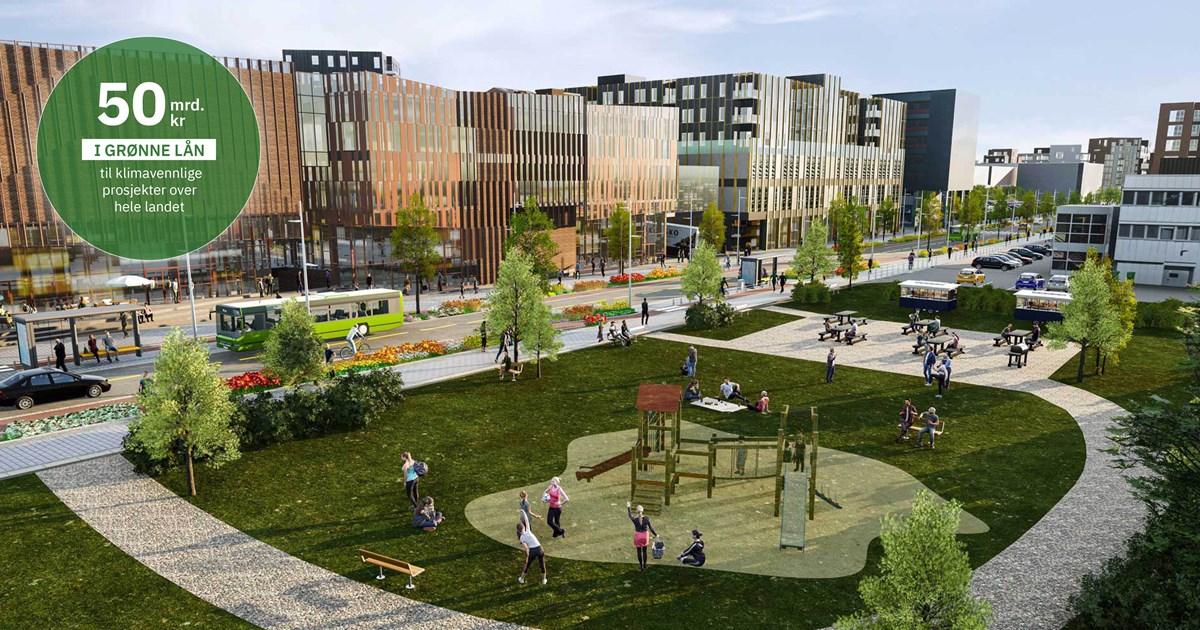KBN reached NOK 50 billion in green loans to the municipal sector
Behind the numbers we find everything from minor initiatives to some of Norway's most ambitious climate projects.
The NOK 50 billion in green loans is divided into seven categories within municipal investments. Below we give you an insight into some of the projects we have lent to.
Transportation
One of the larger green loans in the transport sector was provided by Oslo municipality. The purchase of 87 new trams ensures robust and future-oriented transportation in Oslo. The trams have room for far more passengers than before and are universally designed.
In Møre og Romsdal county, electrification takes place at sea. Several of their fossil ferries have been replaced with electric ferries. Electrical installations on the quay with charging points facilitate a green infrastructure in the years to come.
Buildings
Some of KBN's largest green loans go to construction projects. Some rehabilitate, while others build new.
One of the larger construction projects is the Alta care centre, with 60 care homes and 108 nursing home places. The center is built in solid wood and ground heating will cover 50 per cent of the energy needs.
In our northernmost county, we also find the new Kautokeino primary and secondary school. The total emission reduction from materials, building site and energy is estimated to be 40 per cent of the reference value. The reduction is mainly due to the fact that a significant reduction in energy demand has been achieved. In addition, low-emission materials have been chosen, including solid wood as a supporting material, low-carbon concrete and generally little use of concrete.
Of smaller construction projects, we see a large volume of energy efficiency measures in schools, kindergartens, sports halls and cultural buildings.
Water and wastewater
The focus on water and sewage is increasing. Increased focus is due to maintenance delays and a climate that puts greater pressure on the water and sewage network.
In the water and wastewater sector, water treatment plants and purification plants account for the largest projects we help finance.
One of them is the Langevatn water treatment plant in Rogaland. The facility has the capacity to process 3,300 liters of water per second. After an extensive cleaning process, the water goes out into a 31 kilometer long main line that the municipalities connect to.
Waste and circular economy
What happens to all the waste we leave behind? It varies from municipality to municipality. The recycling station Sørlandsparken Øst will be built in wood and low-carbon concrete, and produce energy from solar cells. Machines used for waste compaction and transport of waste containers at existing facilities have an annual diesel consumption of around 20,000 litres. By replacing the diesel-powered wheel loaders with electric, stationary roller compactors, Avfall Sør will significantly reduce its emissions.
Renewable energy
Several municipalities have opened their eyes to the possibilities within renewable energy. Solar cell systems, heat pumps and energy wells are among the projects for which we have given green loans. In Nordfjordeid, a district heating system based on low-temperature fjord water and heat exchangers was built. The facility supplies more than 100,000 square meters of buildings in the center of Nordfjordeid.
Climate adaptation
In 2023, many municipalities have experienced a climate that is changing. There have been enormous amounts of rainfall in a short period of time. In recent years, we have given several green loans for flood protection, a trend that will probably increase in the future.
One of the flood protection projects is carried out in Ringsaker municipality. Elva Brumunda is referred to as one of Norway's best trout rivers. But in case of ice and flood water, the river has caused problems for nearby buildings. The river sides must therefore be protected against erosion and thresholds must be built and biotope measures made in the river.
Use of land and area projects
Skårersletta street in Lørenskog is the largest area project we have financed in recent years. The new city street will have cycle lanes in both directions, wide pavements and large granite areas, mood lighting and significant elements of plants and trees. As many as 100 insect-friendly trees and 1,500 bushes will be planted in beds designed to handle increased rainfall.
When the project is finished, Skårersletta will, among other things, have a district heating centre, waste extraction and good storm water solutions. In addition, the aim is for traffic to be greatly reduced.
